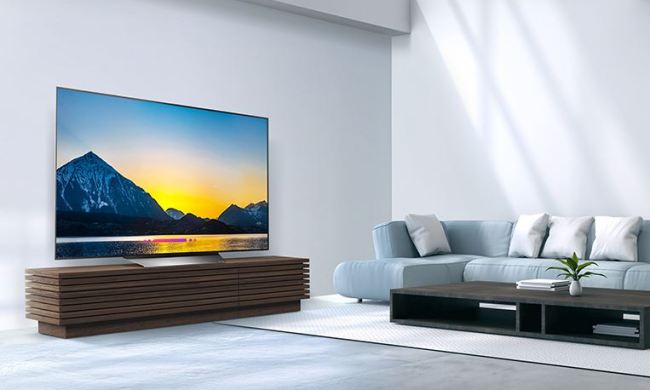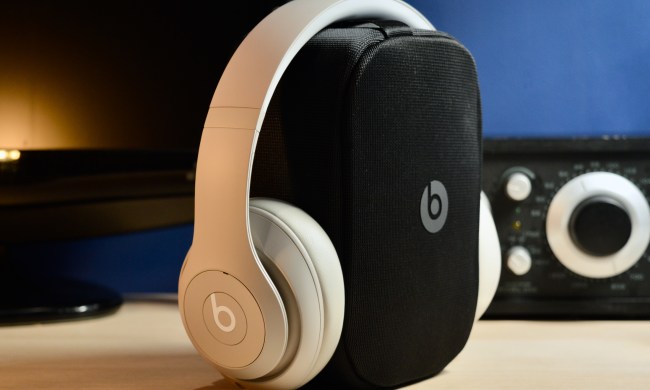“A better headband would make these headphones tough to beat.”
- Sleek design
- Excellent sound quality
- Very good call quality
- Tons of EQ adjustments
- USB-C digital audio input
- Uncomfortable for prolonged use
- No wear sensors
Shure’s latest wireless noise-canceling headphones, the $249 Aonic 40, debuted today at CES 2022, and Digital Trends was fortunate enough to get some hands-on (and ears-on) time with the new cans prior to their official unveiling. The verdict? They are great-sounding, customizable headphones that are only held back from earning our top rating because of an uncomfortable headband design.
Editor’s note: Our original review said that the Aonic 40 do not have Bluetooth Multipoint. This has since been corrected.
Heavy headphones

Shure’s stylists did a knockout job making the Aonic 40 look sleek. Whether you go with the black or white version, the sculpted, single-sided earcup forks give these cans a really elegant and slender profile. They’re bound to catch people’s eyes. But despite their sleek appearance, they’re actually quite heavy at 11 ounces. To put that number in perspective, Sony’s WH-1000XM4 weigh 8.9 ounces, and the Bose QuietComfort 45 weigh just 8.4 ounces.
That a set of cans are on the heavy side doesn’t mean they’ll necessarily be uncomfortable. After all, Apple’s AirPods Max are a beefy 13 ounces, yet they remain comfy thanks to their innovative mesh headband and excellent clamping force.

The Aonic 40 should be comfortable, too – they grip your head with just the right amount of pressure and the headband is wrapped in a soft but grippy silicone rubber. Unfortunately, the headband is narrower than most and the part that makes contact with your head is narrower still. Under that rubber layer is, well, not enough of whatever padding Shure has used.
This all comes together to create a ridge of pressure that I found was passable for the first 30 minutes, but very uncomfortable after that point. By the two-hour mark, I couldn’t take it any more. Wondering if it was just me, I asked my daughter to try them out. She didn’t last 10 seconds before ripping them from her head, saying, “Nope!”
Another small critique: Our review unit had very loose earcup swivel joints which gave the headphones a low-quality feel to the construction.
Satisfying sound

The comfort issue may not be a problem for everyone and I hope that if you buy them, you aren’t bothered by it, because once you start listening, you won’t want to take them off.
I was impressed by how much accuracy and detail Shure managed to pack into its Aonic Free True Wireless earbuds, and the Aonic 40 are just as satisfying. Right out of the box you get very clear high frequencies and a warm yet balanced midrange that helps to reveal a lot of the details that lesser headphones can mask.
And unlike the Aonic Free, which could sound a little cold or harsh at times, the Aonic 40 have a more resonant sound signature. But whether we’re talking about true wireless earbuds or full-size headphones, Shure’s secret sauce is its ShurePlus Play app. Inside, you’ll find one of the most customizable EQ interfaces on the market. It has useful presets that can quickly change the tonal character of the Aonic 40, like Bass Cut, Treble Boost, and Loudness, but it also has a manual mode that imparts an insane amount of control to those who like getting under the hood.
Better yet, if you really like one of the built-in presets, but just want to tweak it ever so slightly, you can duplicate it, adjust it, and save it as a new preset. Absolutely brilliant.
The Aonic Free come with an analog cable for those times when you need to plug in, or if you want to use your own digital-to-analog converter (DAC). But it also lets you use the supplied USB-C cable as a direct digital interface for computers and smartphones, which lets the headphones’ onboard DAC handle all the heavy lifting. It even works while charging, which is something few headphones can claim. With support for AAC, aptX, and aptX HD Bluetooth codecs, the Aonic 40 check some of the most important boxes for wireless audio.
Clear calls

Shure says that calling on the Aonic 40 is a strength and I tend to agree. Even while walking on some very busy streets, the microphones managed to keep most of the unwanted sounds at bay, while keeping my voice perfectly clear. Wind noise was detectable at times, but it was never a deal-breaker. They don’t quite capture as much natural resonance as JBL’s outstanding Tour One, but for phone calls or video meetings, they’ll be more than adequate.
When I initially got my hands on the Aonic 40, I thought they were missing Bluetooth Multipoint — the ability to connect the headphones to two devices simultaneously. The feature isn’t mentioned on the box, in the printed instructions, or in Shure’s press release. Plus, when I tried to connect them to a Mac and an iPhone at the same time, it didn’t work.
However, after a call with Shure’s product expert and a start-from-scratch pairing procedure, I got it working. Hopefully, Shure will update its digital and printed material to help avoid such confusion for buyers.
Cleverly, Shure lets you enable a red indicator LED for when you’re on a call. It would be the perfect way to let others know you shouldn’t be disturbed, even when you’re not talking, except for the fact that it’s hidden at the bottom of the left earcup, where it’s unlikely to be noticed unless you’re looking right at it.
Noise cancellation and transparency

As a set of noise canceling cans, the Aonic 40 successfully take the edge off external sounds. You get three levels of ANC – light, normal, and max – but I couldn’t discern much of a difference between them so I kept them on max the whole time. It’s powerful enough that you can hear callers or podcasts clearly even in pretty noisy situations, but they’re not quite as magically silent when listening to nothing as say, the Bose Noise Cancelling Headphones 700, or the Apple AirPods Max, but then again, they’re considerably less expensive than these models.
Environment Mode (Shure’s name for transparency) is excellent. Fully adjustable and accessible while on calls, you can almost convince yourself that you aren’t wearing headphones. A dedicated button on the right earcup lets you switch ANC modes. I found it a bit awkward to use, but I love the way it works: A single click takes you from ANC to environment mode and then back again, while a long-press turns off both of these modes. It’s a way better user interface than you’ll find on other ANC headphones – which usually make you choose what that button does in an app instead of giving you every option.
Controls
Speaking of controls, they’re pretty standard fare: A single button on the left earcup acts as a dual power/Bluetooth pairing control, while a three-button cluster on the right earcup gives you playback, volume, track skipping, call answer/end. A dedicated button on the right earcup handles ANC and mic muting during calls.
They’re easy enough to use as long as you’re not wearing gloves – but the buttons are too small and too close together to operate accurately without bare fingers.
A feature we’re seeing more and more in wireless headphones is the inclusion of wear sensors that auto-pause the music when you remove them from your head. Sony’s WH-1000XM4 have this, as does Apple’s AirPods Max, but it’s not limited to high-end models — Wyze’s excellent and affordable $70 Wyze Headphones also have it, but Shure did not add it to the Aonic 40.
Battery life
At 24 hours of playtime, the Aonic Free play it pretty safe. That’s more than you’ll get from the AirPods Max or Bose Noise Cancelling Headphones 700 (20 hours), less than you’ll get from the Sony WH-1000XM4 (30 hours) and about the same as the Bose QC45 (24 hours).
We’d prefer it if Shure had given these cans more juice, but when you consider how heavy they already are, perhaps it was the right decision.
Conclusion
When you consider the Aonic 40’s highly competitive $249 price and its many great features, they should be a slam-dunk recommendation. But their uncomfortable headband gives us pause. Still, if you get a chance to try them on and the narrow headband doesn’t bother you, you should seriously consider them.











